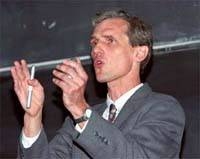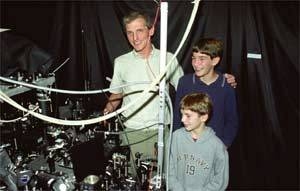Gazing up at a crowd that strained the capacity of Room 10-250, physics head Marc Kastner quipped, "I'd like to welcome the usual audience to the physics colloquium."
The speaker who filled every square inch of stairs, seats and aisles at last Thursday's public lecture was Professor Wolfgang Ketterle. He shares this year's Nobel Prize in physics with two MIT alumni for causing atoms to sing in unison, thus discovering a new state of matter called Bose-Einstein condensate (BEC). BEC has revolutionized atomic physics, spawning thousands of research papers since its discovery in 1995.
BEC was the buzz of the week at MIT after the Royal Swedish Academy of Sciences announced this year's three laureates in physics on Oct. 9: Ketterle, 43; Eric A. Cornell, 39, a 1990 MIT Ph.D. recipient and now a senior scientist at the National Institute of Standards and Technology in Boulder, Colo.; and Carl E. Wieman, 50, a 1973 MIT physics graduate and a physics professor at the University of Colorado at Boulder.
An alternately humbled, gratified and grinning Ketterle accepted an outpouring of good wishes, embraces and slaps on the back from colleagues and friends at MIT and around the world. "It's scary, it's stunning, it's a combination of emotions," he told one of the dozens of callers who flooded his phone Tuesday morning.
This announcement "comes like a bright ray of light in a dark period for MIT and the world," President Charles M. Vest told the print, radio and TV reporters who attended the Oct. 9 news conference in MIT's Marlar Lounge. Ketterle's research team of undergraduates, graduate students and postdoctoral associates were there to cheer him on, as were two of his three children, Jonas, 15, and Holger, 9. Daughter Johanna, 12, opted to go to school that day. Â
Ketterle, the John D. MacArthur Professor of Physics, tried to deflect some of the glow onto Professor David Pritchard; Daniel Kleppner, the Lester Wolfe Professor of Physics; and Professor Thomas J. Greytak, associate department head for education. "I am proud to be at MIT and proud to have such wonderful mentors," he said.
"I am the youngest of four MIT faculty members who pioneered this field in the late 1970s and early 1980s. I am privileged to finish what they had started," said Ketterle, who is associated with MIT's Research Laboratory of Electronics and the National Science Foundation MIT-Harvard Center for Ultracold Atoms, directed by Kleppner. The other two laureates also started their work here: Cornell was Pritchard's postdoctoral associate and Wieman did undergraduate research with Kleppner.
Colleagues and friends
Ketterle, a German citizen, received a Ph.D. from the University of Munich in 1986 and did postdoctoral work at the Max-Planck Institute for Quantum Optics in Garching and at the University of Heidelberg before coming to MIT.
He became a postdoctoral associate in 1990 under Pritchard, a pioneer in atom trapping, atom optics and atom interferometry. Three years later, in an astoundingly generous move, Pritchard gave up one of his experiments to make room for Ketterle in the department.
"What I got was a wonderful colleague," he said at the news conference. "Let's face it--the experiment went a lot better with Wolfgang working on it than me. It's been worth it."
"Wolfgang has remarkable qualities," Kleppner said. "As a scientist, he has this incredible ability to define a vision and to focus his resources. Wolfgang is a superb scientist, a superb teacher and a superb colleague. He is wonderful at everything."
At last Thursday's public lecture, emotions were again running high. Pritchard introduced his protégé by saying that Ketterle is "'A-plus' at everything ... Your most 'A-plus' ability is as a colleague and a friend. My world is tremendously brighter since you walked into my lab, and I'm glad to see MIT is the same way."
Early work
When Ketterle arrived at MIT, Kleppner and Greytak had undertaken the goal of trying to see a Bose-Einstein condensate in an atomic gas.
It was an ambitious goal. "BEC was so far away we didn't even mention it" at first, Ketterle said.
The wave nature of matter does not manifest itself at room temperature. To test the theory that at extremely cold temperatures, all the particles that make up matter would oscillate in concert and form one large, visible matter wave, Ketterle and colleagues decided to trap a gas in a magnetic trap and cool it down.
To accomplish this, the researchers needed the coldest temperatures ever achieved. They used a combination of laser cooling, furthered in large part by Pritchard, and evaporative cooling, developed by Harold Hess, Kleppner and Greytak.
It took two years to build the machinery to trap and cool atoms to around one-millionth of a degree Kelvin, a million times colder than interstellar space. Ketterle was aware that Cornell and Wieman were moving in the same direction.
When Cornell and Wieman achieved BEC in June 1995, Ketterle was stymied. He decided to forge ahead with his own version of the trap that kept atoms from escaping before they reached the lowest temperatures. On one of his group's very last attempts on Sept. 30, 1995, they saw "sharp black spots on the screen. There was very little motion and it was very, very cold. We got clear evidence that we had observed BEC," Ketterle said.
"It was one of the most exciting races of my lifetime," he said.
"We all said to each other, 'You got the best out of me.' If you have competition, you work harder and better."
Understanding BEC
Ketterle says BEC does to atoms what a laser beam does to ordinary light. In the laser, the light particles all have the same energy and oscillate together. In BEC, atoms march in lockstep, demonstrating the wave nature of particles. To cause matter to behave in this controlled way has long been a challenge for researchers.
In the 1920s, the Indian physicist Bose theorized about light particles and Albert Einstein extended the theory to a certain type of atom. Einstein predicted that if a gas of such atoms were cooled to a very low temperature, all the atoms would suddenly gather in the lowest possible energy state. The process is similar to when drops of liquid form from a gas--hence the term condensation.
At such low temperatures, the atomic matter waves overlap and the atoms lose their individual identities. They essentially march in lockstep as a single giant matter wave displaying uniform behavior. In contrast, atoms in an ordinary gas flit around independently.
Properties of new matter
For Ketterle, the new form of matter was magical. "It was like watching how nature is giving birth to something very fragile," he said.
It turns out there are many ways to manipulate this state of matter and observe its quirky properties. Ketterle and his group have made condensates expand and overlap. He produced a stream of small BEC drops that fell under the force of gravity. With this pulsed beam of atoms, he demonstrated the world's first atom laser. He rotated a laser beam around the cloud of ultracold atoms and watched it become polka-dotted with tiny circular whirlpools.
"Like most people who worked on BEC, we thought it would be an exciting development, but we had no idea how interesting it would be and the consequences of it," Kleppner said.
"I think it's wonderful science--maybe one of the most explosive discoveries in my field ever," Pritchard said. Physicists say this new control of matter may bring revolutionary applications in precision measurement, nanotechnology and possibly quantum computation.
Ketterle is now working on an optical trap that enables him to move the atoms from one place to another. "We thought we would be so happy if we could just see BEC," he said. "For me, now the Bose condensate is a new laboratory to do all kinds of new physics. I am privileged to be in the middle of something like this."
A version of this article appeared in MIT Tech Talk on October 17, 2001.








